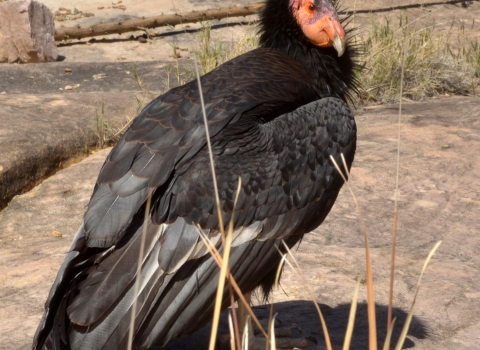DENVER – The U.S. Fish and Wildlife Service (Service), as part of its ongoing efforts to plan for the future of National Bison Range Complex (Complex) in western Montana, recently convened a team consisting of a variety of federal, tribal, state, and local government agencies to develop alternatives for focusing management of the Complex. The Complex consists of four National Wildlife Refuges, the National Bison Range, Lost Trail, Ninepipe, and Pablo National Wildlife Refuges, and two Wetland Management Districts.
The Service is undergoing two Comprehensive Conservation Planning (CCP) processes to focus management and use of the units of the Complex for the next 15 years. As part of the CCP process, this team has outlined the following five draft alternatives to focus future management of the units of the Complex. The first alternative, known as the No Action Alternative, would maintain the current management, and keep funding, infrastructure, all programs, and staffing at existing levels. The other four alternatives, commonly known as the action alternatives, are as follows:
Maximize the Quality of Public Experiences
This alternative emphasizes managing habitat and wildlife populations to provide quality, wildlife-dependent opportunities for the public. All programs of the Complex would foster public support and appreciation for the resources of our land and our waters. The Service would maximize these recreational opportunities by providing improved access, facilities, interpretive materials, and environmental education. The Service would aim to maintain natural processes and healthy wildlife populations through partnerships to enhance the quality of the public’s experience.
Manage for Ecological Sustainability
This alternative emphasizes maintaining and/or enhancing ecological communities, recognizing ever-changing environmental conditions. In cooperation with our partners, the Service would use a prioritization framework to identify and define future conditions that will drive management actions to:
- Build ecological community resiliency
- Promote species diversity
- Increase integrity of habitats
- Restore natural processes
Species-Focused Management
Under this alternative, carrying capacity for target species would generally drive management of wildlife and plant population numbers. Lands would be managed under a corridor concept for transient species populations (e.g. wolverine, lynx, grizzlies, wolves). Carrying capacity for bison would be determined in concert with carrying capacities for other species. Bison population management would also involve genetic diversity considerations. Targeted species populations (e.g. Spalding’s catchfly, trumpeter swans, and bighorn sheep) would be managed with individualized considerations (e.g. disease, threatened and endangered species, and habitat). Management objectives would include managing for a diversity of species, including plant species.
Collaborative/Partner-Based Landscape Level Conservation
Units of the Complex are separated by significant distance across the landscape. All are part of the Northwestern Montana ecosystem. To provide connectivity with the larger landscape and preserve unique components of each small unit, this alternative seeks to facilitate collaborative, cooperative, and coordinated management of the Complex with our federal, tribal, state, local, public, and private partners. This alternative seeks to increase opportunities for public use and education. It seeks to provide better opportunities for fish, plant, and wildlife habitat on lands outside the boundaries of our units by creating corridors for habitats, conducive to wildlife migration and movement. It also seeks to incorporate the expertise, resources, and efforts of our partners to help facilitate the benefits of a broader functioning landscape. This approach promotes the shared responsibility of managing actions across the landscape.
The Service is seeking public input on these alternatives for 30 days, until May 25, 2018. The Service will also hold four public meetings on these alternatives. Information about each meeting is detailed below:
Date: May 9, 2018
Time: 5:00 p.m. - 8:00 p.m.
Location: Montana Fish, Wildlife and Parks Office
Address: 490 N. Meridian Rd., Kalispell, MT 59901
Venue Phone: (406) 752-5501
Date: May 10, 2018
Time: 5:00 p.m. - 8:00 p.m.
Location: Leon Hall
Address: 984 Leon Road, Charlo, MT 59824 (NE corner of Leon Road and Kerns Road)
Venue Phone: (406) 644-2145
These meetings will follow an open-house format. Brief presentations will be provided at 6:00 p.m., but attendees are invited to arrive anytime between 5:00 p.m. and 8:00 p.m. to meet with Service personnel, learn more about the CCP process, and provide input.
In addition to the evening open house meetings, the Service will also be hosting all-day open house events at the National Bison Range and Lost Trail refuge headquarters. The public is invited to stop by the refuges at any time during the following days to meet with Service personnel, learn more about the CCP process, and provide input.
Date: May 11, 2018
Time: 8:00 a.m. - 4:00 p.m.
Location: National Bison Range Headquarters
Address: 58355 Bison Range Rd., Charlo, MT 59824
Venue Phone: (406) 644-2211
Date: May 8, 2018
Time: 8:00 a.m. - 4:00 p.m.
Location: Lost Trail Refuge Headquarters
Address: 6295 Pleasant Valley Rd., Marion, Montana 59925
Venue Phone: (406) 858-2216
After the public comment period, the Service will evaluate the comments received to inform and refine the draft alternatives. The next phase of the planning process will be to analyze the environmental impacts of each of the draft alternatives.
The mission of the U.S. Fish and Wildlife Service is working with others to conserve, protect, and enhance fish, wildlife, plants, and their habitats for the continuing benefit of the American people. For more information on our work and the people who make it happen in the West, connect with us through any of these social media channels: Facebook, Twitter, Flickr, YouTube, and Instagram.



